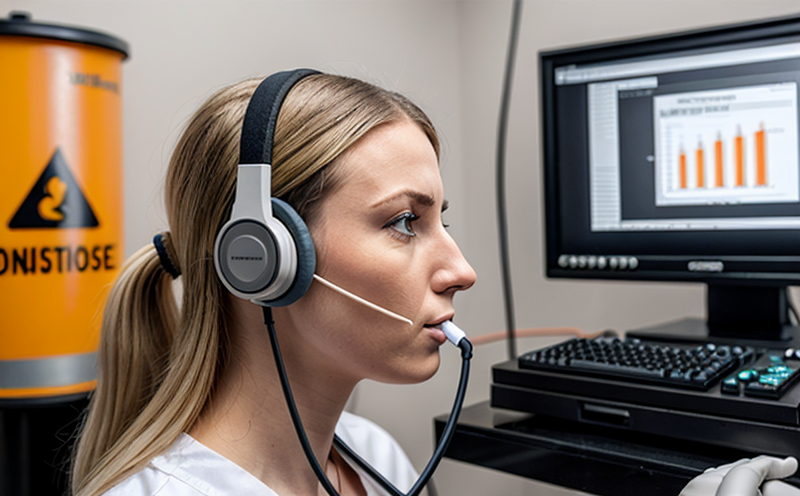ISO 9614-1 Sound Power Testing by Intensity Scanning
The ISO 9614-1 standard is a cornerstone in the field of acoustics, vibration, and noise testing. This method provides precise measurement techniques for determining sound power levels from noise sources using intensity scanning. The procedure involves placing two microphones equidistantly on either side of a source to measure the intensity of sound waves. By analyzing these measurements, the sound power level can be calculated.
This approach is particularly useful in environments where traditional microphone-based methods may not yield accurate results due to boundary effects or reflections from surfaces. The method ensures that noise sources are accurately characterized, which is crucial for compliance with occupational health and safety regulations such as those outlined by OSHA (Occupational Safety and Health Administration) and EU Directives.
The process typically begins with a detailed site survey of the area where testing will take place. This includes understanding room acoustics and potential interference from external sources. Once the setup is complete, the intensity scanning equipment is calibrated according to ISO 9614-1 standards. During the test, the microphones are positioned precisely and the sound field is scanned in multiple directions.
The collected data is then processed using specialized software that calculates the sound power level of the source. This information can be used to assess compliance with noise exposure limits set by regulatory bodies such as ISO or OSHA. It also allows for the evaluation of hearing protection devices and their effectiveness in reducing noise levels.
Introducing intensity scanning into your quality assurance processes ensures that you are meeting stringent international standards while providing valuable insights into workplace safety practices. This method is widely recognized across industries including manufacturing, construction, and transportation where high decibel levels pose significant risks to employees' hearing health.
- Reduces exposure to hazardous noise: By accurately measuring sound power levels, employers can implement effective measures to minimize occupational noise exposure.
- Promotes safer working environments: The data provided by this testing helps organizations create safer workplaces and protect their employees from hearing damage.
- Facilitates compliance with regulations: Ensures that all measurements meet the required standards set forth by relevant authorities like OSHA or EU Directives.
- Evaluates hearing protection devices: Provides reliable information on how well different types of earplugs or earmuffs perform in reducing noise levels.
In conclusion, ISO 9614-1 sound power testing by intensity scanning offers a robust solution for assessing and managing occupational noise exposure. Its precision and reliability make it an indispensable tool for ensuring both regulatory compliance and worker safety.
Scope and Methodology
The scope of ISO 9614-1 sound power testing by intensity scanning includes the measurement of airborne sound power levels from noise sources such as machinery, tools, or other equipment used in industrial settings. The methodology involves setting up two microphones at specific distances from a source, ensuring they are aligned parallel to each other and perpendicular to the direction of propagation.
The test setup must be conducted under controlled conditions to minimize external interference. Once the environment is stabilized, the intensity scanning process begins by moving one microphone along a predetermined path while keeping the second stationary. Data points are recorded at various positions until a complete scan has been achieved.
The collected data undergoes rigorous processing using algorithms prescribed in ISO 9614-1 to calculate the sound power level of the source. This value represents the total amount of acoustic energy produced by the noise source during its operation. It is typically expressed in decibels (dB) and serves as a key indicator for assessing compliance with occupational health standards.
It’s important to note that while this method provides highly accurate results, it requires careful planning and execution. Proper calibration of equipment, precise positioning of microphones, and adherence to standard procedures are essential for obtaining reliable measurements.
Benefits
Implementing ISO 9614-1 sound power testing by intensity scanning offers numerous advantages that contribute significantly to workplace safety and compliance. Firstly, it helps organizations identify areas within their facilities where noise levels exceed safe thresholds, enabling proactive measures to be taken promptly.
- Precise measurement: The method ensures accurate quantification of sound power levels, providing reliable data for decision-making purposes.
- Compliance assurance: By adhering strictly to ISO standards, businesses can demonstrate their commitment to meeting regulatory requirements and avoiding potential legal issues.
- Improved hearing health: Early identification of high-risk zones allows employers to implement appropriate controls such as engineering modifications or administrative actions like staggering shifts.
- Cost-effective solutions: Identifying problematic areas early on prevents costly remediation projects later down the line by allowing for targeted interventions.
In addition, this testing approach fosters a culture of continuous improvement within organizations. Regular monitoring allows management teams to track progress over time and adjust strategies as necessary based on changing conditions or new technologies becoming available.





